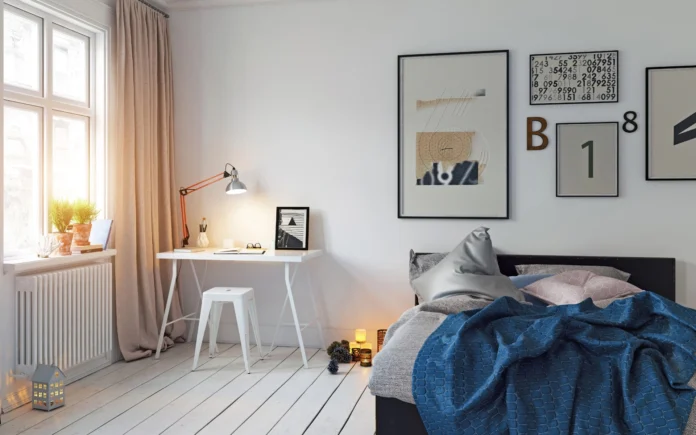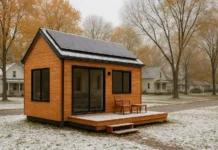Did you know your bedroom is more than just a place to sleep? With our increasingly fast-paced lives, a simple bedroom interior design creates a private sanctuary where you can truly unwind and recharge.
In fact, the right simple bedroom design balances relaxation space with practical storage solutions while still feeling vibrant and alive. We believe that creating a clutter-free environment makes your room feel more spacious and naturally relaxing. Moreover, implementing bedroom interior design simple principles can transform your personal space into one that reflects your personality while providing that much-needed escape from everyday life.
As we head into 2025, modern bedroom designs are evolving to blend luxury, function, and comfort—especially for urban lifestyles. However, you don’t need complicated designs to achieve this balance. Simple designs often incorporate neutral color palettes and straightforward furniture arrangements, which can make daily cleaning and maintenance easier.
Plan Your Bedroom Layout

The foundation of any successful bedroom makeover begins with understanding your space. Before browsing through furniture catalogs or interior design ideas, I recommend taking a step back and planning your bedroom layout methodically.
Measure your room dimensions
Creating a simple bedroom interior design starts with accurate measurements. Grab a measuring tape and note down the exact length, width, and ceiling height of your room. Additionally, measure alcoves, built-in features, and the location of windows and doors. These measurements will prevent costly mistakes like ordering furniture that won’t fit through doorways.
I suggest creating a simple sketch of your room with these measurements as your reference point throughout the design process. For most American homes, the average bedroom size is approximately 132 square feet (11′ x 12′), which comfortably fits a queen-sized bed and small wardrobe. If you’re working with a master bedroom, ideal dimensions typically range between 12′ x 14′ to 14′ x 16′.
Decide bed placement and walking space
The bed is undeniably the focal point of your bedroom, so its placement deserves careful consideration. Generally, I recommend positioning your bed against the longest wall if possible, avoiding blocking windows or creating awkward traffic patterns.
For comfortable movement around your bedroom, maintain these essential clearances:
- At least 24 inches of walking space around the sides of the bed
- 30-36 inches between the foot of the bed and opposite wall for queen beds
- 36-42 inches for king beds to prevent the space from feeling cramped
This circulation space ensures you can easily access your bed from both sides and comfortably open wardrobes or drawers without obstacles. For smaller bedrooms, an L-shaped arrangement works well—place your bed in one corner and use remaining wall space for a dresser or desk.
Consider natural light and ventilation
Natural light plays a crucial role in regulating your sleep-wake cycle (circadian rhythm). Proper exposure to daylight during waking hours helps you feel more alert and energetic. Consequently, bedroom layout planning should account for window positions and light patterns.
If you enjoy waking up with the sun, consider partially placing your bed along a south-facing wall. Alternatively, if you prefer darker sleeping conditions, a north-facing wall might be ideal. For maximum flexibility, install blackout curtains that can block light at night but open easily in the morning.
Ventilation is equally important for quality sleep. When deciding on furniture placement, think about how air moves through your room. Adequate airflow prevents stuffiness and creates a more comfortable sleeping environment. Position your bed to take advantage of cross-ventilation when possible, avoiding placements that block air circulation between windows or vents.
By carefully planning these three fundamental aspects of your bedroom layout—measurements, bed placement, and environmental factors—you’ll establish a solid foundation for the subsequent design elements of your simple bedroom interior.
Choose a Simple Color Palette
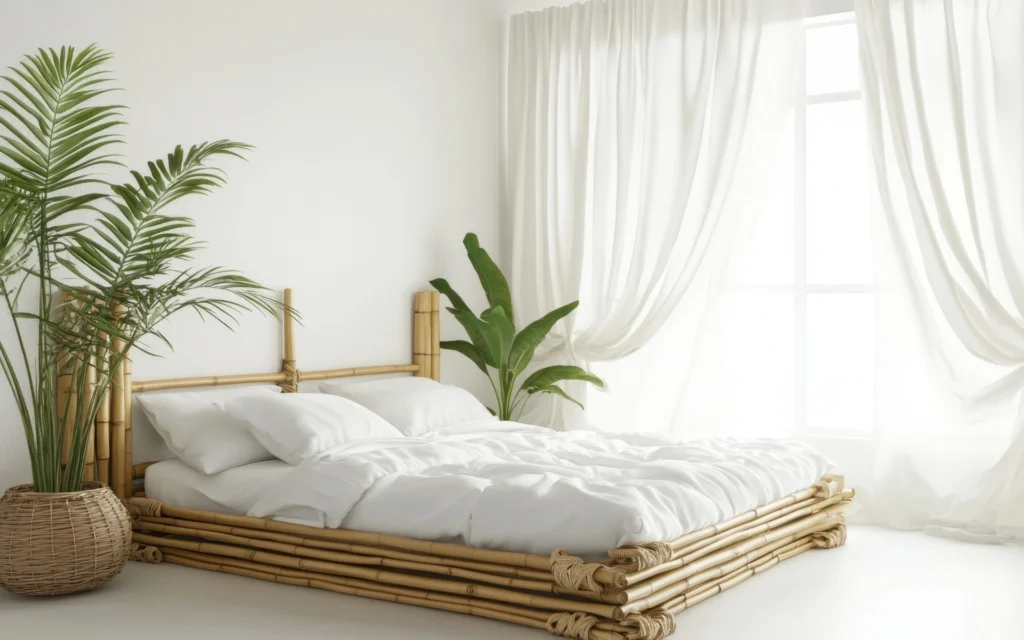
Selecting the right colors for your bedroom sets the foundation for a restful environment. Colors influence our minds and moods significantly, with some shades promoting relaxation while others energize the space. Let’s explore how to create a simple color palette that transforms your bedroom into a peaceful sanctuary.
Neutral tones for a calm look
Neutral colors remain timeless favorites for bedroom designs due to their versatility and ability to create serene environments. These shades extend beyond just white and beige, encompassing a range of hues with subtle undertones.
For a bedroom that promotes relaxation and comfort, consider these calming options:
- Warm whites like Roman Column by Sherwin-Williams create a cozy, inviting atmosphere while making the room feel spacious
- Soft gray serves as one of the most popular bedroom colors because of its soothing, neutral effect
- Earthy taupe with gray undertones (like Stirabout) creates a totally calm space, particularly when used on all surfaces including the ceiling
- Soothing cream promotes relaxation while offering flexibility for accent colors
When working with neutrals, the key to success lies beyond just color selection. Texture, pattern, and subtle shimmer will make neutral palettes sing. Mix different neutral shades within the same family (sharing similar undertones) to create visual interest without overwhelming the space.
Accent walls for subtle contrast
An accent wall provides a focal point and ties room elements together cohesively while preventing your simple bedroom design from feeling flat. This technique works particularly well behind the bed, creating a natural visual anchor.
For subtle yet effective contrast:
- Paint just half a wall for visual interest without overwhelming the space—try navy on the bottom with white on top to make ceilings appear taller
- Implement a two-tone design to break up solid colors, which prevents patterns from visually cluttering the space
- Consider an ombré effect, starting with the darkest shade at the bottom and gradually lightening upward for a serene effect
Fundamentally, when creating an accent wall, make it darker than surrounding walls to establish a clear focal point that immediately draws attention. This contrast works beautifully with the neutral base palette while adding dimension to your simple bedroom wall design.
How color affects room size perception
Colors possess remarkable power to alter spatial perception without moving a single wall. Understanding these effects helps you manipulate your room’s visual dimensions:
- Lighter and cooler colors make spaces appear larger and more open—ideal for small bedrooms
- Darker colors create a cozy, intimate feeling by absorbing light, making rooms feel smaller but more enclosed
- Ceiling color impacts perceived height—painting it lighter than walls makes a room feel taller
To visually widen a narrow room, paint the back wall and ceiling with the same darker color while keeping side walls lighter. Conversely, if a room feels too wide, paint opposing side walls darker while leaving the background and ceiling light.
For small bedrooms specifically, earthy beige tones can make interiors appear more spacious while simultaneously adding warmth and coziness. Additionally, consider matte or silk finishes rather than high-gloss options, as they don’t reflect excessive light that might disturb sleep.
As a result, your color choices become powerful tools in creating the perfect simple bedroom interior design—one that feels appropriately sized, visually balanced, and conducive to rest.
Select Essential Bedroom Furniture

Furniture selection represents the tangible elements that bring your simple bedroom design to life. After planning your layout and choosing colors, it’s time to select pieces that balance functionality with esthetics.
Low-height bed with storage
A low-height bed creates an illusion of spaciousness by reducing visual bulk in your bedroom. Furthermore, beds with built-in storage compartments eliminate the need for additional furniture pieces, making them ideal for compact spaces. These beds typically sit 350mm from the ground, allowing easy access for children and elderly individuals.
Storage beds come in various configurations:
- Hydraulic storage designs that lift the entire mattress, revealing spacious storage underneath
- Drawer storage beds with compartments accessible from the sides
- Box storage options with four separate compartments for organized storage
When selecting a storage bed, consider durability and weight capacity. Most engineered wood beds last approximately 5 years with proper care. Essentially, your bed should provide both comfort and practical storage without dominating the room visually.
Sliding wardrobe for space-saving
Unlike traditional hinged door wardrobes, sliding designs don’t require clearance space for doors to swing open—a crucial advantage for smaller bedrooms. This space-saving feature makes them perfect for rooms with limited square footage or awkward layouts.
Beyond space efficiency, sliding wardrobes offer numerous benefits:
- Smooth functionality with quiet operation for hassle-free daily use
- Versatile storage with adjustable shelves, hanging rails, and integrated drawers
- Enhanced organization that makes clothing and accessories easily accessible
- Sleek esthetics that complement modern interiors
For a truly minimalist approach, choose sliding wardrobes with monochromatic finishes that blend with your walls, creating a cohesive look that makes the room appear larger.
Minimal bedside tables and dressers
Bedside tables are essential for keeping nighttime necessities within arm’s reach. Initially, focus on functionality—a table with at least one drawer provides storage while maintaining a clean surface. For smaller spaces, floating bedside tables free up floor area and create an airy, open look.
Complete your bedroom furniture ensemble with a compact dresser. Given space constraints, consider:
- Vertical designs that utilize height rather than width
- Multifunctional pieces that can serve as both storage and workspace
- Corner units that maximize unused spaces
When selecting dressers, prioritize pieces that complement your overall design while providing adequate storage. In tight spaces, wall-mounted or floating designs maintain floor clearance, creating visual lightness that’s essential for simple bedroom interior design.
Add Simple Wall and Lighting Features
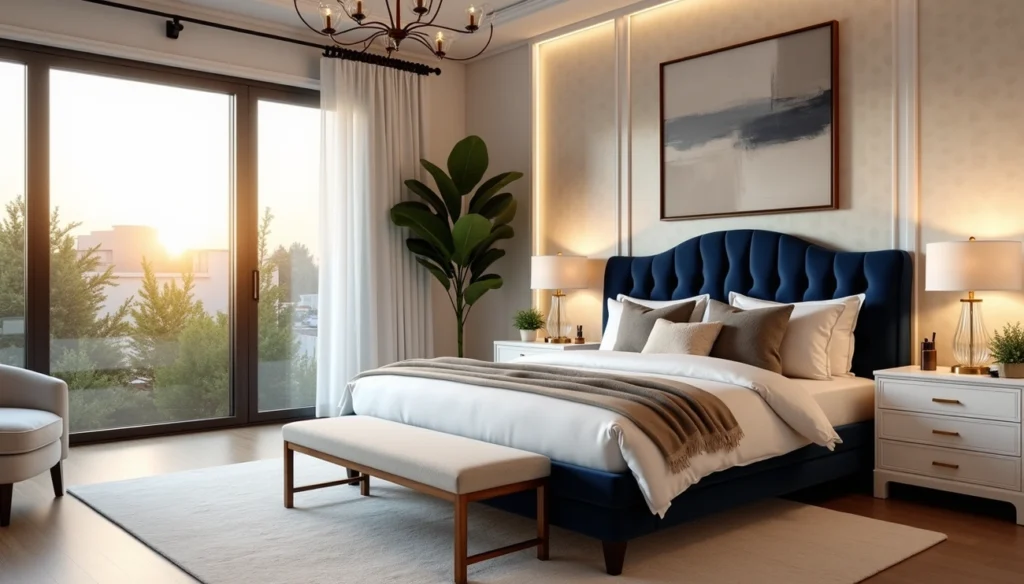
Lighting and wall features form the finishing touches that elevate a simple bedroom design from basic to beautiful. Once you’ve arranged your furniture, these elements create atmosphere and personality without cluttering your space.
Use of soft cove lighting
Cove lighting involves installing light fixtures into recessed areas or concealed channels within walls or ceilings. This technique creates indirect, diffused illumination that transforms your bedroom’s ambiance. Notably, cove lighting works exceptionally well in bedrooms as it produces a gentle glow without harsh shadows, ideal for creating a calming environment.
For simple installation, consider:
- LED strips tucked behind headboards for a soothing backlit effect
- Light strips along ceiling perimeters or under crown moldings
- Soft illumination behind floating shelves
Indeed, the concealed nature of cove lighting provides a clean, minimalist appearance while adding warmth and sophistication to your space.
Simple bedroom wall design ideas
Walls occupy the largest visual space in your bedroom, making their design crucial yet straightforward. Amid various options, consider these simple approaches:
First, textured walls add character without overwhelming the space. Limewash paint creates subtle variations in texture and tone, giving your bedroom wall a raw, organic feel. Alternatively, textured wallpapers offer an easy-to-execute and cost-effective solution.
Second, create a statement wall using a calming shade like moss green or sea blue as your focal point. For added dimension, consider rectangular recessed boxes carved into the wall.
Third, upholstered accent walls behind your bed spread a luxurious feeling while enhancing comfort. Materials like velvet, leather, hemp cotton, or jute work wonderfully.
Mirrors and textures for depth
Mirrors do more than just reflect your image—they expand visual space. Placing a mirror opposite a window helps reflect natural light throughout your room, making it appear larger and brighter.
For small bedrooms, consider:
- A large mirror opposite a window to double perceived space
- Mirror-framed vanity areas for both function and style
- Floor-length mirrors to create an illusion of depth
Fundamentally, mirrors can emphasize key design elements when placed above headboards or dressers, drawing attention to these areas and creating a cohesive feel to your bedroom layout.
Decorate with Function in Mind
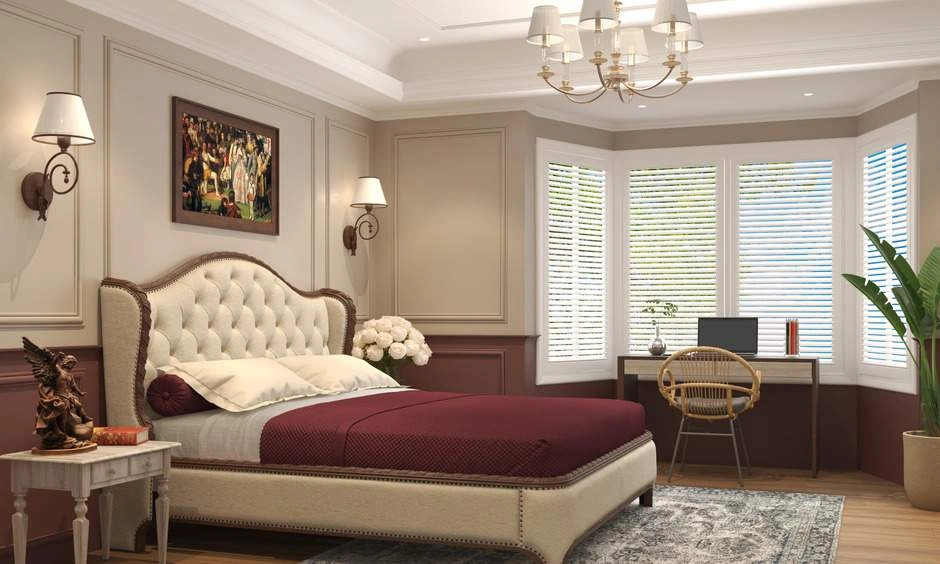
Functional decoration transforms your bedroom from simply habitable to truly livable. After establishing the fundamentals, how you accessorize determines whether your space remains practical long-term.
Simple room decoration ideas that work
I’ve found that decorating with intention creates lasting impact. Question each item before bringing it into your bedroom: “Does this belong here?” or “Would I buy this today?”. This approach prevents accumulating unnecessary items that eventually become clutter.
For nightstands, stackable organizers keep essentials accessible while maintaining clean surfaces. Likewise, personal touches matter—display only select decorative pieces that genuinely make you happy, like a special photo frame or meaningful figurine.
Use of indoor plants and rugs
Indoor plants serve multiple purposes beyond esthetics. Lemon balm emits a gentle citrusy scent that naturally calms anxiety and alleviates insomnia symptoms. Similarly, snake plants produce oxygen at night, making them ideal companions for better sleep. For those with limited gardening experience, air plants require minimal care—occasional misting suffices.
Regarding rugs, placement matters tremendously. A large rug under your bed with the seam positioned beneath creates a plush foundation that softens acoustics throughout. Alternatively, runner-style rugs around the bed provide comfort for your first morning steps. For under-bed storage accessibility, flatwoven rugs prevent sliding accidents.
Keep surfaces clutter-free
Maintaining clear horizontal surfaces forms the cornerstone of a peaceful bedroom environment. Accordingly, implementing daily habits proves more effective than occasional deep cleaning. Put clothes away immediately after changing, return kitchen items promptly, and unplug and coil cords after use.
Establish designated zones for frequently used items—labeled storage bins for medicines, jewelry, and electronics prevent random placement. Furthermore, removing unnecessary furniture eliminates potential clutter-catching surfaces.
Conclusion
Simple bedroom interior design offers far more than esthetic appeal. Throughout this guide, we’ve explored how thoughtful planning transforms your bedroom into a personal sanctuary that balances function and style. Your bedroom serves as both your starting and ending point each day, therefore creating a space that promotes relaxation becomes essential for overall wellbeing.
Layout planning undeniably forms the foundation of any successful bedroom design. Proper measurements, strategic bed placement, and consideration of natural light establish the framework upon which all other design elements build. Similarly, a neutral color palette creates the calm atmosphere necessary for quality rest while accent walls add personality without overwhelming the space.
Furniture selection plays a crucial role in maintaining simplicity. Low-height beds with built-in storage, space-saving sliding wardrobes, and minimal bedside tables maximize functionality while preserving visual openness. Additionally, soft cove lighting, thoughtfully designed walls, and strategically placed mirrors work together to enhance the perception of space.
Lastly, decoration choices determine whether your bedroom remains a peaceful retreat long-term. Indoor plants improve air quality while adding natural elements, quality rugs add comfort and warmth, and clutter-free surfaces maintain the tranquil environment you’ve worked to create.
Remember, simple bedroom interior design doesn’t mean boring or lacking personality. Rather, it focuses on intentional choices that support both functionality and personal style. When each element works harmoniously together, you’ll find yourself with a bedroom that truly feels like home—a place where you can unwind, recharge, and face each new day refreshed.


